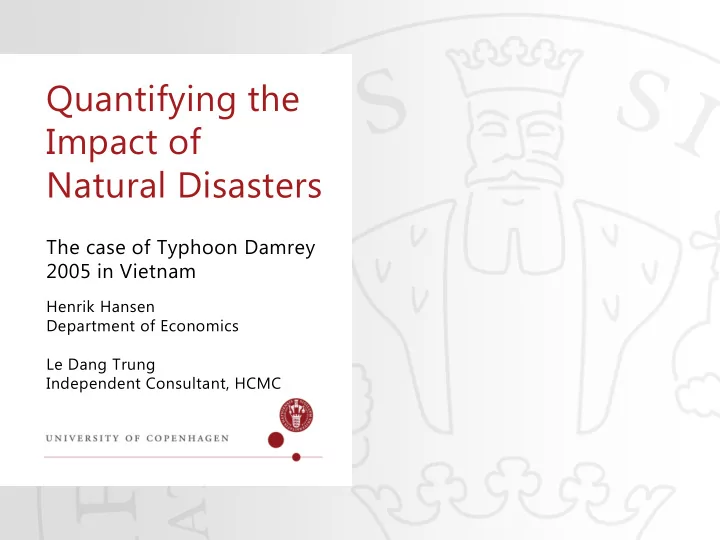

Quantifying the Impact of Natural Disasters The case of Typhoon Damrey 2005 in Vietnam Henrik Hansen Department of Economics Le Dang Trung Independent Consultant, HCMC
UNU-WIDER Conference: Responding to Crises 23/09/2016 2 Background • Natural disasters hit with increasing frequency, especially in costal areas • We wish to calculate the costs of the disasters… • For insurance schemes and policies • For cost-benefit analyses and socio-economic planning • To learn more about the welfare implications of climate change
UNU-WIDER Conference: Responding to Crises 23/09/2016 3 Two simple measurements of disaster costs • We mainly obtain cost figures by asking people in surveys • Either just after an event has occurred • Or as part of regular household surveys • Both types of information have potential problems: • Who is asking just after the event? An aid- worker, a government official, a researcher… The answer may well depend on the enumerator • What influences a recall survey answer: • Ex ante perceptions and preparations Ex post disaster responses • (which are functions of ex ante perceptions and preparations)
UNU-WIDER Conference: Responding to Crises 23/09/2016 4 Requirements for “objective” cost calculations To calculate costs of a disaster we need: 1. A precise mapping of the disaster area 2. A measure of welfare indicators in the disaster area after the disaster 3. A measure of welfare indicators in the disaster area after the disaster – but without the disaster! This is a typical evaluation problem in the social sciences
UNU-WIDER Conference: Responding to Crises 23/09/2016 5 The Impact evaluation This talk shows a feasible way of computing objective costs using: 1. Detailed storm data, 2. A wind speed model, 3. Household survey data, and 4. Statistical analysis We try to answer the questions: 1. Who are affected by Typhoon Damrey? 2. What are short-term impacts? 3. Are the impacts persistent? 4. What are the coping strategies, households rely on?
UNU-WIDER Conference: Responding to Crises 23/09/2016 6 We look at a specific event: Hurricane Damrey
Some visible impacts of Damrey
UNU-WIDER Conference: Responding to Crises 23/09/2016 8 Identification of the affected area: A wind speed model by Holland (1980) b b R 2 2 max b R R f Rf R max V R ( ) ( P P ) e env centre R 4 2
UNU-WIDER Conference: Responding to Crises 23/09/2016 9 The affected area of Typhoon Damrey and spots where we have information about well-being The affected area has wind speeds above 35 knots ~ 65 km/h ~ 40 mph
UNU-WIDER Conference: Responding to Crises 23/09/2016 10 Establishing a comparison group: Storms in Vietnam 1951-2008 • We select comparison areas using multivariate matched sampling (Propensity Score Matching) • The most important variable is the long-term probability of being hit by storms • Other control variables include: distance to the coast, commune area and population size
UNU-WIDER Conference: Responding to Crises 23/09/2016 11 The survey data We have the data from the Vietnam Household Living Standard Surveys Before Damrey: 2004 (pre-storm situation) After Damrey: 2006 (short-term post data) After Damrey: 2008 (long-term post data) Total Sample: 6939 households in rural communes Damrey hit 792 households in 264 rural communes of the VHLSS We select 801 households in 1909 unaffected communes to form the comparison group
UNU-WIDER Conference: Responding to Crises 23/09/2016 12 The affected area of Typhoon Damrey and comparison areas
UNU-WIDER Conference: Responding to Crises 23/09/2016 13 Outcomes to examine the Impact • Paddy production • Crop income • Sidelines income • Total income • Food expenditure (self-consumed and bought) • House repairs
UNU-WIDER Conference: Responding to Crises 23/09/2016 14 Estimates of the Short-term Impact (2006-2004) • Paddy production (yield): loss = 0.1 kg/m 2 ~ 20 % of 2004 yield • Crop income: 30% lower, but not significant • Sidelines income: no significant loss • Total income: no significant loss • Food self-consumed: somewhat increase • Food bought: significant decrease (14%) • Total food consumption: significant decrease • House repair probability: increase by 20% • House repair expenses: increase by 25% of poverty line
UNU-WIDER Conference: Responding to Crises 23/09/2016 15 Estimates of the Long-term Impact (2008-2004) • Paddy production (yield): No impact • Crop income: No impact • Sidelines income: No impact • Total income: No impact • Food self-consumed: significant decrease • Food bought: increase (but insignificant) • Total food consumption: No impact • House repair probability: increase by 10% (but insignificant) • House repair expenses: increase by 50% of short-term impact
UNU-WIDER Conference: Responding to Crises 23/09/2016 16 Coping strategies • Households invest more in subsequent paddy production • Households rely on remittances ($100) • Households increase borrowing: • formal loans ($1300) • informal loans ($1000) • Disaster aid: not significant
UNU-WIDER Conference: Responding to Crises 23/09/2016 17 Summary We have tried to develop • An objective method to identify storm-affected areas, • providing data for estimation of the storm impact, which • allows for impact assessment based upon existing data • This could be a foundation for • index-based insurance products, • cost-benefit analyses, and wider impact assessments of climate changes •
Recommend
More recommend